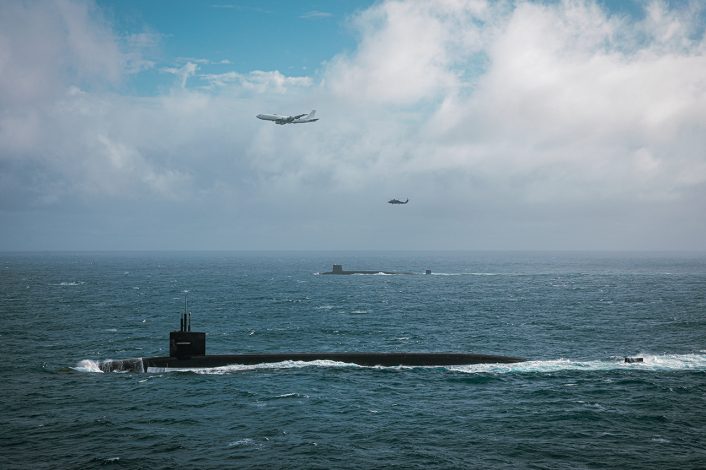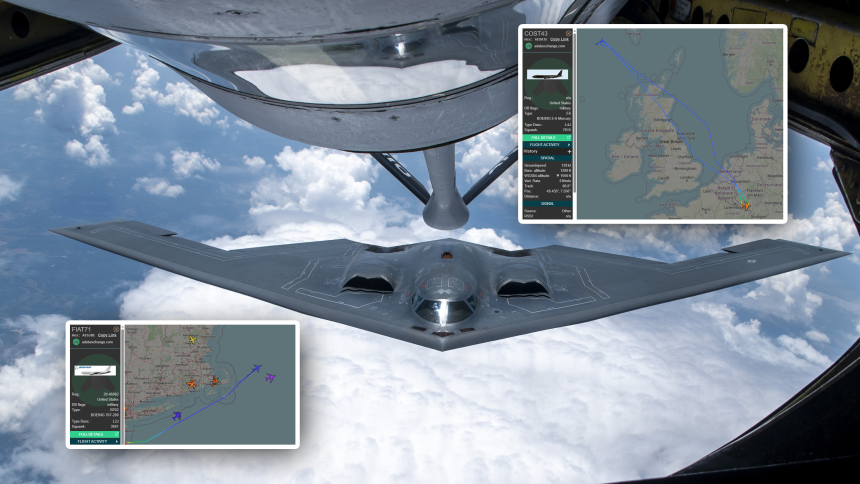B-2 Spirit stealth bombers launched from Whiteman AFB on a transatlantic round-trip sortie, supported by an E-6B Mercury flying from Ramstein. Let’s look at what happened.
The appearance on Sept. 21, 2025, of a U.S. Navy E-6B Mercury over European skies signaled to many enthusiasts who monitor the activities of U.S. strategic forces that they should expect what is widely known as a ‘Skymaster Exercise’ in the following few days. ‘Skymaster Exercises’ involve U.S. Strategic Command (STRATCOM) assets like strategic bombers and airborne command posts, and usually last for hours or days, compared to the multiple week Global Thunder and Global Lightning STRATCOM exercises. The term (applied by enthusiasts) stems from the callsign SKYMASTER, frequently used on the U.S. Air Force High Frequency Global Communications System (HFGCS) during this type of exercise and thought to be a collective callsign for active airborne command posts like E-4B Nightwatch and E-6B Mercury aircraft.
In the early hours of Sept. 24, the expected exercise began in earnest with the launch of ZOLAR 11 and ZOLAR 12 from Whiteman Air Force Base, Missouri. This flight of two B-2A Spirit stealth bombers routed east towards the U.S. east coast, then northeast towards the AR20 aerial refueling track over Nova Scotia, Canada. At least one of the B-2s was topped up with fuel by a KC-46 Pegasus flying under the callsign FIAT 71.
ZOLAR 11 & 12 (B-2A Stealth Bomber) refueling with FIAT 71 (KC-46) on the AR20NE track over Nova Scotia. 💪😎 pic.twitter.com/FEOgzYiARq
— Thenewarea51 (@thenewarea51) September 24, 2025
Around the time of this first refueling, enthusiasts noted the first use (in this exercise) of the SKYMASTER callsign on HFGCS, with an unidentified station using the callsign FAKE 11 (alternatively reported as SAINT or FATE, actual callsign unclear). FAKE 11 passed “two messages of four items” – two groups of four alphanumeric characters to SKYMASTER. ZOLAR 11 could be heard calling SKYMASTER a few hours later.
Last night’s SKYMASTER event took place, as expected.
The first call to SKYMASTER was at 02:30 UTC. @ParssinenPaulus‘ livestream for 11175 kHz got a good capture of the audio;https://t.co/A5Apr4qgLF
— NEET INTEL (@neetintel) September 24, 2025
At some point before reaching the Santa Maria oceanic airspace, controlled from the Azores, ZOLAR 12 had returned to head back to Whiteman as an air spare. Flying spare aircraft to at least the first refueling leg of a long-distance sortie is common practice for strategic bombers. Not only does it rehearse the very real possibility that during an operational mission, part of an intended strike package might not be able to make it all of the way to the target, but it also means that for deployments and exercises they can almost guarantee the intended number of aircraft will take part.
ZOLAR 11, now flying as a single ship, continued to a position off the northwestern tip of Spain, then holding to await another refueling. This time, the tanker was a KC-135 from the 100th Air Refueling Wing at RAF Mildenhall, UK, callsign RAKE 24.
KC-135R #RAKE24 is up for AR with B-2 #ZOLAR11 along ALTRV “FLASH WHISKEY”, after which they’ll recover into Porto.
58-0100 / #AE04FE pic.twitter.com/LSdXkmwcHq
— EISNspotter 🇮🇪 (@EISNspotter) September 24, 2025
Having completed its planned route, ZOLAR 11 now returns to head back to the U.S. along a similar route. Above Maine, the aircraft’s fuel tanks once again receive a top off from a waiting KC-135.
zolar11 b-2 bomber is 60 miles north of Bangor out of 34,000 feet and descending to 24,000 feet to get refuel originally from main86 but 86 is having a disconnect issue and maine85 is still up in the area and they will now take the mission. maine86 holding over bangor right now. pic.twitter.com/BPgqJ4N1OV
— Kevin Badger (@KevinBadger15) September 24, 2025
Looking Glass
As ZOLAR 11 made its way across the Atlantic towards Spain, the E-6B Mercury earlier forward deployed to Ramstein got airborne and headed northwest. Skimming the eastern coast of the United Kingdom, COST 43 was bound for an area over water near the Faroe Islands, between Iceland and the UK (in the famed GIUK gap) which had been notified a week in advance as in use for military purposes from the surface up to an altitude of 30,000 feet.
On HFGCS, COST 43’s mission crew, using the callsign WOODLAND, were active and issuing coded messages called Emergency Action Messages (EAMs). These messages are transmitted ‘in the clear’, though they cannot be decoded without the corresponding key (thought to be using one-time pads).
COST43 (E-6B TACAMO) broadcasting a EAM on HF with a backend callsign WOODLAND pic.twitter.com/OT3gWpaphW
— Thenewarea51 (@thenewarea51) September 24, 2025
The aforementioned block of airspace extending from the surface to 30,000 feet is important to note, because it means there is clear airspace for the E-6B Mercury to deploy its trailing wire antennas. A pair of wires, one extending as long as 28,500 feet, and the other to about 5,000 feet, are carried by the E-6B aircraft to facilitate its primary role of communicating with submerged submarines. Both of these wires work in tandem – the shorter one carries the transmission, while the longer one wraps around it and droops down almost to sea level, acting as a counterpoise, or ground plane.
These antennas allow the E-6B to transmit Very Low Frequency (VLF) messages, which are able to penetrate below sea water to a maximum depth of around 130 feet (40 meters). This allows transmissions to be sent to submarines without a need for those submarines to surface, vital for ballistic missile submarines which must remain undetected to properly fulfill their strategic duties. The submarines are unable to respond in kind, so this is a one-way affair.
As with High Frequency (HF) communications, VLF transmissions can be received using internet-hosted radios. Unlike with HFGCS, which mostly uses voice communications, messages sent by E-6B aircraft over VLF are in teletype format, so need to be translated using simple computer software into readable letters and numbers.
COST 43 (E-6B TACAMO) broadcasting a EAM on VLF over the North Atlantic this morning. 💪😎🇺🇸 pic.twitter.com/MwlcrhpP3x
— Thenewarea51 (@thenewarea51) September 24, 2025
The use of VLF in this mission could mean that a U.S. Navy submarine also took part in the exercise, though it may also be possible that the EAMs were transmitted over VLF without an intended recipient simply for training purposes.
WOODLAND remained on station in its airspace block for just under three hours before heading back to Ramstein. E-6B deployments to Europe used to happen on a regular basis, with the aircraft often deploying to Stuttgart Airport where U.S. European Command (EUCOM) is headquartered. Over the past few years, deployments have still happened but have been on a less routine and more sporadic basis. A number of operating locations have been used, including some which haven’t before hosted E-6B operations. These trips have often coincided with very deliberately visible exercises alongside other U.S. strategic assets, including ballistic missile submarines.

Notably, the E-6B’s successor, the E-130J Phoenix II, is thought to be excluding the Looking Glass mission set in favor of a focus on the ‘Take Charge and Move Out’, or TACAMO, submarine communications mission. If this does end up being the case, future strategic exercises by U.S. Air Force bombers may no longer be able to rely on the Navy’s TACAMO fleet, and an alternative platform will need to be fielded by the U.S. Air Force to fill the gap.
SKYMASTER
As the exercise kicked off, and was noticed by enthusiasts like NEET Intel, and Thenewarea51 with large follower counts, it soon came to the attention of more sensationalist accounts. Some would go onto proclaim the use of the callsign SKYMASTER as a sign of impending nuclear war. While the tactical use of strategic exercises as a geopolitical posturing tool cannot be ruled out, and is in fact likely to occur on some level, we should be cautious drawing links between these exercises and any ongoing real world events, let alone the start of a nuclear war. Skymaster exercises and the larger Global Thunder and Global Lightning exercises are regular, routine events, that have been held several times a year for many years. If anything, it is likely that many of these accounts are aware of the actual nature of the exercise, and are simply fishing with clickbait.
SKYMASTER EXERCISE taking place today with multiple B-52, KC-135, E-6B TACAMOs, and EAMs 😎
DECEE02 flt (KC-135) clg BULK05 flt (B-52) to refuel over Missouri pic.twitter.com/sVfdMZZEpd
— Thenewarea51 (@thenewarea51) October 24, 2024
The next Global Thunder is likely to commence in October or November, while Global Lightning 26 is due to kick off in Q2 of 2026. These exercises see STRATCOM practice a full nuclear war scenario, with mass launches of bombers and support tankers as well as the simulated destruction of ground units. Ground forces even get involved, staging nuclear security drills that see personnel ‘re-capturing’ Minuteman III nuclear missile silos. Skymaster exercises – again, a name assigned by enthusiasts – appear to be lower key affairs simulating singular missions or situations rather than a full war plan.

In some ways, SKYMASTER now seems to have inherited the conspiratorial impact online that once belonged to the callsign SKYKING. An often repeated, and easily debunked, myth would state that training exercises would see transmissions repeat the callsign twice – i.e. “SKYKING, SKYKING” – before proceeding with a message, while real world nuclear war would be heralded by three uses of the callsign. As we can see with regular HFGCS traffic, the act of repeating a callsign twice is in fact just routine practice for communications, with the format of many HFGCS message types being very standardised in order to be as clear and understandable as possible. When calling any available station, aircraft will call “MAINSAIL, MAINSAIL”, and in the above recordings of a SKYMASTER message you can hear FAKE 11 calling “SKYMASTER, SKYMASTER”.
Operation Poker
On the same night, France’s airborne strategic nuclear forces also conducted a major exercise simulating a nuclear strike mission. Four such exercises are usually held each year under the codename ‘Poker’. This exercise was Poker 2025-03, with 2025’s other Poker exercises having been held in March and in May. March’s exercise was noted as the first time since 2021 that the mission had been rehearsed during daylight hours.
A large part of France’s A330 Multi-Role Tanker Transport (MRTT) fleet took part in the exercise, supporting both ‘blue team’ and ‘red team’ fighter aircraft. The blue team aircraft go up against defending red team aircraft and air defences in their attempt to deliver a nuclear payload, carried by France’s unique ASMP-A nuclear cruise missile on board Dassault Rafale fighter aircraft. An E-3F Sentry AWACS aircraft also watched over the exercise participants.
♠️♦️POKER | 2025-03🔄[MAJ H+2.75]
1/3
Le raid arrive désormais en Méditerranée pendant que les RED se mettent en place… Décollage de 5 MRTT.
Les premiers chasseurs en BA devraient arriver d’ici peu. Tandis que les chasseurs porteurs de l’arme sont attendus un peu plus… pic.twitter.com/iZgejVOJdn
— Trackeur ADS-B 🇫🇷 📡 (@TrackeurADSB) September 23, 2025
France’s air launched deterrent is one of the country’s two nuclear weapon delivery methods, the other being based on board four Triomphant class ballistic missile submarines. The air launched deterrent provides a very visible presence, and, under French nuclear doctrine, can be called on to act as a final ‘warning shot’ before the deployment of the strategic submarine-based deterrent’s ballistic missiles.
Nuclear armed air-launched cruise missile ASMP-A loaded on a Rafale M about to launch from French aircraft carrier Charles de Gaulle. 2023. pic.twitter.com/Gn5g64nHjK
— Tom Antonov (@Tom_Antonov) February 13, 2025
Though some drew a link between the simultaneous exercises of both the U.S. and France, the overlap was most likely a simple coincidence. Unlike the UK’s Trident missiles, France’s nuclear weapons are not a declared NATO capability. France is the only NATO member that is not also a member of NATO’s Nuclear Planning Group, which oversees NATO’s overall nuclear strategy, a remnant of France’s fiercely independent streak and its absence from NATO’s unified command structure entirely between 1966 and 2009. As such, France’s nuclear deterrent very much operates on its own feet and without much need for the interoperability afforded by such an exercise.
The French @DGA has awarded ArianeGroup the contract to design and produce the M51.4 strategic missile.
➡️ Enhanced range, precision & penetration will reinforce the credibility of France’s oceanic nuclear deterrent in response to evolving threats. pic.twitter.com/WSKlnev9tm
— ArianeGroup (@ArianeGroup) September 12, 2025
In 2025, France and the UK signed a deal which will see increased cooperation between the two nations’ nuclear strategies. However, the background behind the signing of this deal – the uncertainty over U.S. President Donald Trump’s commitment to defending Europe – means similar cooperation with U.S. forces seems unlikely. French and UK ballistic missile submarine operations have, in the past, been so independent of each other that their patrol areas appear to have overlapped, causing a collision between ballistic missile submarines HMS Vanguard and Le Triomphant.
Though, on balance, the French exercise was likely unrelated, the coincidence is interesting nonetheless, and is a strong signal of NATO’s overall capability.









